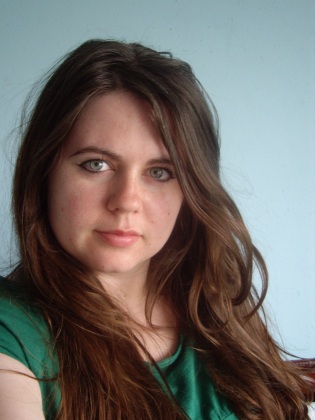Interview: Lindsey Dryden

In her short film Close Your Eyes and Look At Me, Lindsey Dryden explores the issue of personal freedom, body and ways of seeing. She talks to Kamila Kuc about her fascination with radical women and respect she has for Shabana, the subject of her film.
Kamila Kuc: Close Your Eyes and Look at Me portrays Shabana, a young Muslim woman from Edinburgh, who talks about the meaning of wearing a hijab. Using a hijab as a starting point, the film explores the issue of racism and intolerance in the UK. I like the way the first few minutes of the film are shot: we do not see Shabana’s face but we hear her voice…
Lindsey Dryden: That was deliberate. I first filmed an interview with Shabana, and then spent a good few weeks thinking about how to give the film a visual structure, and avoid the dreaded ‘talking heads’ approach, before going back to shoot the little journey around Edinburgh (thanks to camera operator Glenda Rome for her calm head in the face of camera breakdown!). After some good advice from an editor friend, I kept coming back to the idea of challenging the viewer to think about how they look, and are looked at.
I’m aware that a little meander around grey Edinburgh streets could be thought of as a pretty dull visual approach, but I wanted to ask the viewer to contemplate what it feels like not to see someone you’re being asked to engage with, and what it is we assume about them based on first (visual) impressions. People I heard from at the last screening of the film (True/False Film Festival) said they were desperate to know what Shabana looked like by the end, and in that way had to think about their appetite to understand someone’s appearance as well as their thoughts and actions.
Also, it was brave of Shabana to take part in the filming as – like many of the most interesting people – she wasn’t that keen to be the centre of attention. So I wanted to find a way to film her that honoured that, and didn’t feel too pressured for her.
KK: The title is crucial to the film as Shabana asks an important question: ‘Why what people wear, has such a significant impact on our opinion of them?’ Do you find yourself guilty of that sometimes?
LD: Yes, of course. My obsession with being non-judgmental is an ideal, not a reality! It would be wonderful to be magically non-judgmental all the time, but I think that – for better or worse – we all need signifiers about a person to tell us who they are and what they might mean to us.
I think the problem, though, is that commercial imperatives have really got in the way, and now our bodies and appearance have apparently become our most important attribute, and the primary way we’re taught to judge and exert power over people (mainly because if we feel insecure we’ll often do our best to make others feel bad, in order to make ourselves feel better, and if we all feel insecure then we’ll all buy more crap to fix it). I’m writing a book about body image, and exploring the importance of attractiveness and bodily health on everyday human interactions, and how we judge each other – hopefully I’ll find some answers that bring that non-judgmental ideal a little closer!
KK: Is the film your way of exploring the issue through Shabana’s eyes or is it a question that Shabana wanted to explore and you filmed it?
LD: I was researching the theme of radical women – women who are doing extraordinary things in the wake of some daft Daily Mail idea that feminism is dead – and became intrigued by the notion that some Muslim women find covering hugely liberating because, at a time when looks seem to be everything, it frees them to be looked at as a person, not just as a woman who is a sum of her parts. There are at least 10 films that could be made with Shabana as she’s an informed and passionate woman with so many ideas! But I approached her about exploring this particular topic, and we did it that way round.
I did film with another brilliant Muslim woman in Edinburgh, initially on the same topic; but we ended up moving into all kinds of different and interesting territory, so I’m still pondering which story to focus on, and looking forward to what comes of that.
KK: Shabana says that hijab allows her for a certain kind of freedom where she does not have to think about having to wear make-up before she leaves home. But then one does not need to wear a hijab for that…There is a serious conflict in perceiving the whole issue as many Western women see hijab as an oppression rather than liberation…
LD: Shabana’s hijab is an incredibly important part of her religious observance, so of course it’s not just about not having to wear make-up. There are many reasons she’s committed to covering, and I think being perceived as free from the dull and restrictive physical rituals of our culture (girls have long flowing hair, girls wear make-up, girls look pretty all the time, blah blah) is one of the many benefits for her.
And no, you don’t need to wear a hijab for that – but I think for most people it’s very hard to step out of their culture’s physical rituals, whether wearing make-up, or having those long, flowing locks, or shaving legs (good old fashioned feminist fare!) because pressures to conform are incredibly strong… which goes back to the idea of why we judge people based on looks. So, while this kind of freedom is not the main or only reason Shabana wears hijab, it’s a pretty good bonus, I imagine!
As for conflict in perceiving this issue – absolutely, there’s conflict. All of these things are based on belief systems, and intensely personal choices, many of which have been so normalised that they seem to be instinctive. Is a woman who covers her hair oppressed because her religion is forcing her to conceal her ‘femininity’? Or is a woman who beautifies her hair oppressed because her culture is forcing her to believe that her main value is in the way that she looks, and that her so-called ‘femininity’ is a real and natural part of her?
Shabana is quick to distinguish between those who choose, proudly and fully informed, to wear hijab, and those who are forced to wear it by their community, or family, or government. For her, covering was absolutely a choice, based on careful reflection and life experience, and I find her passion and fierce belief humbling and inspiring. As she said at the time of filming, most women who wear hijab would like everyone else to understand that they’re just normal people!
KK: Hijab, of course, is an expression of Shabana’s belief, which unlike any other religion, seems to cause controversy around the world…
Yes, Shabana’s hijab is a very significant part of her faith, not something she takes lightly, and not something that’s interchangeable with a bit of eye-liner. But by comparing hijab to how other women wear make-up, I think she’s highlighting that women across cultures, races and religions have something in common: we subscribe to observances and rituals around our bodies that are key to how we are perceived in the world – and we can’t leave the house without them!
The ‘just a piece of cloth’ phrase came up because we were talking about exactly that controversy, and that panic that many people (dopey politicians like Jack Straw included) feel at the mere sight of a headscarf. While we were filming she said, “Why’s it such a big deal if we use cloth to cover our head, or cover our hair or our neck? We’re still that same person inside. If you actually sat down and spoke to someone, if you just closed your eyes that hijab would vanish, it wouldn’t even be a reason to use against somebody, it wouldn’t even factor in to your opinion of that person.” I think she’s making an important point – perhaps my expression of it is a bit trite, but why not look beyond what you see on the surface?
And yes, Islam seems to cause a fair bit of uproar in the West at the moment; but of course pretty much all the other major religions (or perhaps just small and noisy groups claiming to represent them) have done so at various points in history.
KK: Do you think your film could change people’s perceptions about wearing a hijab?
LD: I think a little film like this can only be the beginning of a discussion – and that’s what storytelling is for, no? To raise questions, tell us a little something about other human beings, and in turn show us a little something about ourselves so that we keep questioning, questioning, questioning. I was honoured to hear and record Shabana’s opinions, and in squashing only a part of her many stories down to 6 little minutes, I’d hope that anyone who watches the film takes it as a small – and far from complete – window on the world of someone whose passion and belief is inspiring.
On the way to my shoot with Shabana, I met a taxi driver in rural North Wales who had some disturbing opinions about Islam, although not out of malice – she simply had no experience outside of her own very un-diverse community and, alas, probably read the Daily Mail a little too often. It would be nice if she saw the film and recognised that people she thinks of as foreign are more like her than she realised, but then perhaps I’m into trite territory again… So I think having respect for the person who’s been brave enough to air their opinions, and using them as the starting point for an interesting – perhaps even opinion-shifting – discussion would be a very good start.
To read a review of the film, click here.


